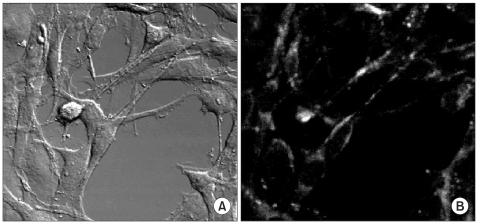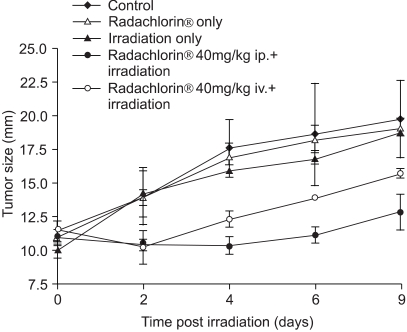Cancer Res Treat.
2004 Dec;36(6):389-394.
Photodynamic Effects of Radachlorin(R) on Cervical Cancer Cells
- Affiliations
-
- 1Catholic Research Institutes of Medical Science, The Catholic University of Korea College of Medicine, Seoul, Korea.
- 2Department of Obstetrics and Gynecology, The Catholic University of Korea College of Medicine, Seoul, Korea. ahnws@catholic. ac.kr
- 3Department of Obstetrics and Gynecology, The Catholic University of Korea College of Medicine, Daegu, Korea.
- 4Department of Chemistry, Kangwon University, Gangwondo, Korea.
Abstract
- PURPOSE
Photodynamic therapy (PDT) is a novel treatment modality, which produces local tissue necrosis with laser light following the prior administration of a photosensitizing agent. Radachlorin(R) has recently been shown to be a promising PDT sensitizer. In order to elucidate the antitumor effects of PDT using Radachlorin(R) on cervical cancer, growth inhibition studies on a HPV-associated tumor cell line, TC-1 cells in vitro and animals with an established TC-1 tumor in vivo were determined. MATERIALS AND METHODS: TC-1 tumor cells were exposed to various concentrations of Radachlorin(R) and PDT, with irradiation of 12.5 or 25 J/cm2 at an irradiance of 20 mW/cm2 using a Won-PDT D662 laser at 662 nm in vitro. C57BL/6 mice with TC-1 tumor were injected with Radachlorin(R) via different routes and treated with PDTin vivo. A growth suppression study was then used to evaluate the effects at various time points after PDT. RESULTS: The results showed that irradiation of TC-1 tumor cells in the presence of Radachlorin(R) induced significant cell growth inhibition. Animals with established TC-1 tumors exhibited significantly smaller tumor sizes over time when treated with Radachlorin(R) and irradiation. CONCLUSION: PDT after the application of Radachlorin(R) appears to be effective against TC-1 tumors both in vitro and in vivo.
Figure
Reference
-
1. Henderson BW, Dougherty TJ. How does photodynamic therapy work? Photochem Photobiol. 1992; 55:145–157. PMID: 1603846.
Article2. Oleinick NL, Evans HH. The photobiology of photodynamic therapy: cellular targets and mechanisms. Radiat Res. 1998; 150:S146–S156. PMID: 9806617.
Article3. Ochsner M. Photophysical and photobiological processes in the photodynamic therapy of tumors. J Photochem Photobiol B. 1997; 39:1–18. PMID: 9210318.4. Dougherty TJ, Gomer CJ, Henderson BW, Jori G, Kessel D, Korbelik M, et al. Photodynamic therapy. J Natl Cancer Inst. 1998; 90:889–905. PMID: 9637138.
Article5. Berns MW, Rettenmaier M, McCullough J, Coffey J, Wile A, Berman M, et al. Response of psoriasis to red laser light (630 nm) following systemic injection of hematoporphyrin derivative. Lasers Surg Med. 1984; 4:73–77. PMID: 6235419.
Article6. Nir U, Laden H, Malik Z, Nitzan Y. In vivo effects of porphyrins on bacterial DNA. J Photochem Photobiol B. 1991; 11:295–306. PMID: 1816365.7. Rywkin S, Ben-Hur E, Malik Z, Prince AM, Li YS, Kenney ME, et al. New phthalocyanines for photodynamic virus inactivation in red blood cell concentrates. Photochem Photobiol. 1994; 60:165–170. PMID: 7938215.
Article8. Andersson-Engels S, Johansson J, Svanberg K, Svanberg S. Fluorescence imaging and point measurements of tissue: applications to the demarcation of malignant tumors and atherosclerotic lesions from normal tissue. Photochem Photobiol. 1991; 53:807–814. PMID: 1886939.
Article9. Bodner K, Bodner-Adler B, Wierrani F, Kubin A, Szolts-Szolts J, Spangler B, et al. Cold-knife conization versus photodynamic therapy with topical 5-aminolevulinic acid (5-ALA) in cervical intraepithelial neoplasia (CIN) II with associated human papillomavirus infection: a comparison of preliminary results. Anticancer Res. 2003; 23:1785–1788. PMID: 12820459.10. Barnett AA, Haller JC, Cairnduff F, Lane G, Brown SB, Roberts DJ. A randomised, double-blind, placebo-controlled trial of photodynamic therapy using 5-aminolaevulinic acid for the treatment of cervical intraepithelial neoplasia. Int J Cancer. 2003; 103:829–832. PMID: 12516106.
Article11. Keefe KA, Tadir Y, Tromberg B, Berns M, Osann K, Hashad R, et al. Photodynamic therapy of high-grade cervical intraepithelial neoplasia with 5-aminolevulinic acid. Lasers Surg Med. 2002; 31:289–293. PMID: 12355576.
Article12. Hillemanns P, Korell M, Schmitt-Sody M, Baumgartner R, Beyer W, Kimmig R, et al. Photodynamic therapy in women with cervical intraepithelial neoplasia using topically applied 5-aminolevulinic acid. Int J Cancer. 1999; 81:34–38. PMID: 10077149.
Article13. Pahernik SA, Botzlar A, Hillemanns P, Dellian M, Kirschstein M, Abels C, et al. Pharmacokinetics and selectivity of aminolevulinic acid-induced porphyrin synthesis in patients with cervical intra-epithelial neoplasia. Int J Cancer. 1998; 78:310–314. PMID: 9766564.
Article14. Nakamura H, Suzuki Y, Takeichi M, Saito T, Takayama M, Aizawa K. Morphologic evaluation of the antitumor activity of photodynamic therapy (PDT) using mono-L-aspartyl chlorin e6 (NPe6) against uterine cervical carcinoma cell lines. Int J Gynecol Cancer. 2002; 12:177–186. PMID: 11975677.
Article15. Krimbacher E, Zeimet AG, Marth C, Kostron H. Photodynamic therapy for recurrent gynecologic malignancy: a report on 4 cases. Arch Gynecol Obstet. 1999; 262:193–197. PMID: 10326640.
Article16. Dougherty TJ. An update on photodynamic therapy applications. J Clin Laser Med Surg. 2002; 20:3–7. PMID: 11902352.
Article17. Levy JG, Obochi M. New applications in photodynamic therapy. Introduction. Photochem Photobiol. 1996; 64:737–739. PMID: 8931369.
Article18. Bae SM, Huh SW, Park EK, Lee KH, Lee JM, Namkoong SE, et al. Photogem induces necrosis in various uterine cervical cancer cell lines by PDT. Cancer Res Treat. 2003; 35:549–556.
Article19. Wooten RS, Smith KC, Ahlquist DA, Muller SA, Balm RK. Prospective study of cutaneous phototoxicity after systemic hematoporphyrin derivative. Lasers Surg Med. 1988; 8:294–300. PMID: 2969070.
Article20. Dartsch PC, Coppenrath E, Coppenrath K, Ischinger T. Photodynamic therapy of vascular stenosis: results from cell culture studies on human endothelial cells. Coron Artery Dis. 1993; 4:207–213. PMID: 8269213.21. PDT Korea Co., LTD. Handbook of Clinical PhotoDynamic Therapy. 2001. PDT Korea Co., LTD;p. 1–70.22. Lin KY, Guarnieri FG, Staveley-O'Carroll KF, Levitsky HI, August JT, Pardoll DM, et al. Treatment of established tumors with a novel vaccine that enhances major histocompatibility class II presentation of tumor antigen. Cancer Res. 1996; 56:21–26. PMID: 8548765.23. Privalov VA, Lappa AV, Seliverstov OV, Faizrakhmanov AB, Yarovoy NN, Kochneva EV, et al. Clinical trials of a new chlorin photosensitizer for photodynamic therapy of malignant tumors. Proc SPIE. 2002; 4612:178–189.
- Full Text Links
- Actions
-
Cited
- CITED
-
- Close
- Share
- Similar articles
-
- Photodynamic Therapy for Recurrent Head and Neck Malignancy
- The effect of photodynamic therapy using Radachlorin on biofilm-forming multidrug-resistant bacteria
- Clinical efficacy of photodynamic therapy
- Photodynamic Therapy in the Management of Cervical Intraepithelial Neoplasia
- Photodynamic Therapy for Esophageal Cancer






